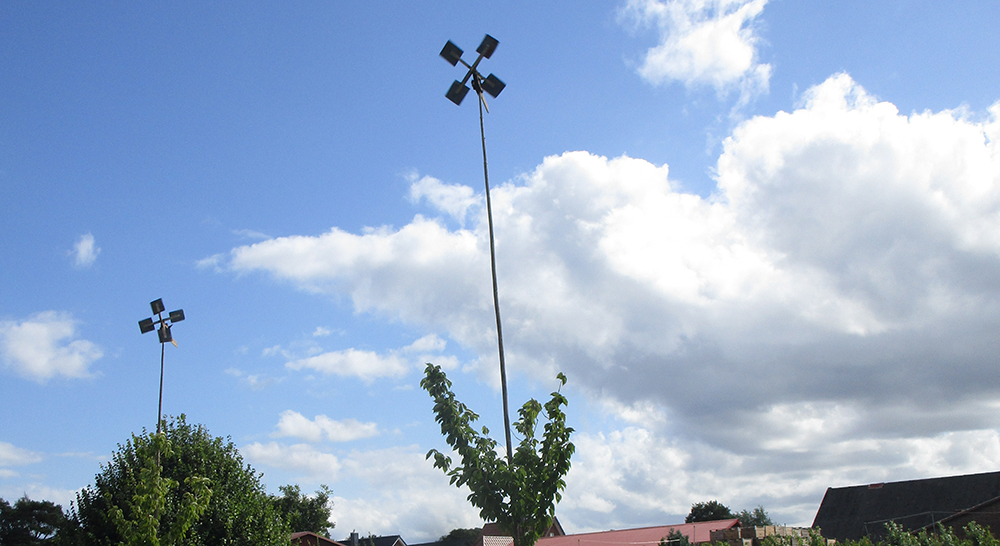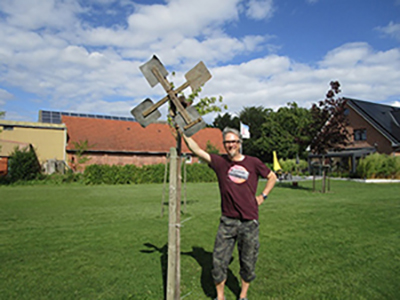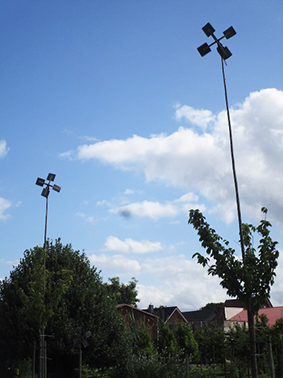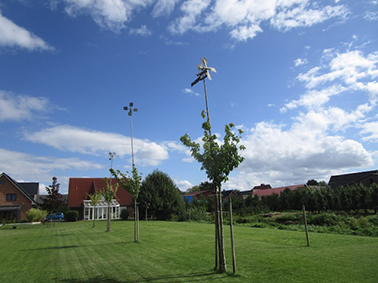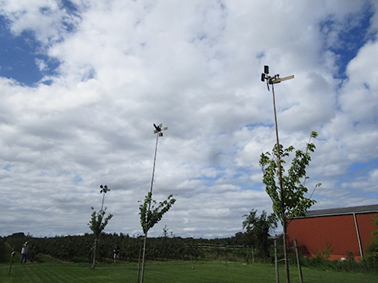Chattering Mills
The Sound of Summer in the "Altes Land"
Although the world was much quieter forty years ago , summers in the "Altes Land"** were generally loud! In my childhood and youth, it was normal to be woken up at 6 a.m. by cannon blasts, wild human shouting, the roar of muffler-less motorbikes, hand clappers, and—most of all—by chattering mills. Luckily, I was a pretty good sleeper back then, and the noise never really robbed me of my rest.
The mechanical chattering mills were the most memorable because they clattered throughout the entire day (depending on the wind)—later replaced by gas cannons, which operated automatically and didn’t require a human presence.
For those who aren’t from the "Altes Land" or belong to younger generations, let me explain: chattering mills were wind-powered devices on tall poles that made a racket. This was necessary to protect the cherry harvest. Starlings—locally called Spreen—love cherries just as much as we do, and in the summer, swarms would descend on the cherry trees and gorge themselves—unless... yes, unless someone was there to “guard against the Spreen” and scare them away.
The human method worked best and during summer holidays we often earned some pocket money for making as much noise as possible all day long, ideal for kids, wouldn't you say? But farmers were inventive; above mentioned canons worked well, too, and the chattering mill worked well for decades. It's not sure when chattering-mills where first used or who invented then, but they probably became popular during the second half of the 19th century. As soon as cherries changed colour from green to red they went up. They usually stayed up from early June until early August i.e. when the cherry harvest was over. First they chattered all day and night, later farmers had to disable them during the night.
Since the late 1980s, all of this has become a thing of the past, and today it’s hard to imagine what summers in the "Altes Land" used to sound like. Nowadays, cherry orchards are covered with nets, or the entire plantation is housed under plastic sheeting and roofs (which also protects the cherries from rain or hail—another reason why harvests sometimes failed in the past). Additionally starlings have sadly nearly vanished from the face of the earth, too.
I moved away in 1989 and have only returned to the "Altes Land" for family visits, never spending an entire summer there again. But I still fondly remember those summer holidays when there wasn’t much to do—except listening to the noise. Chattering mills were fascinating, as they depended on the wind. There were days of total calm (often humid, which the Spreen especially liked), and the chattering mills only clattered now and then. On other days, a light breeze would set them off irregularly—sometimes fast, sometimes slow, and very arrhythmically to a musician’s ears. On windy days, they clattered all day long—but even then, never in a steady rhythm, always changing speed. Windy days weren’t favoured by the Spreen either, so they showed up less frequently.
In 2015 I heard about the "save our sounds" campaign by the British Library, which made me realise that the sound of the chattering mill, one that sounded throughout the "Alte Land" for a long time during the summer, had been lost to the world, never to return. A long search for those devices began, and finally in 2025 I found a friend who had stored some of these devices in a barn for decades. After a few days assembly, I've managed to make some recordings, which I would like to share now.
My piano piece “Klappermühle / Chattering Mill” is intended to reflect the behaviour and, as far as possible, the sound of the chattering mills. I deliberately ignored the metronome, and my playing is not smooth. It is meant to capture the irregularities of varying wind strengths. At the beginning of the piece, the wind is soft, then occasionally a few gusts appear. The middle section represents a windy day before it gradually calms down again and towards the end of the piece wind blows steadily.
** Altes Land:
From: www.hamburg.com/
The Altes Land region of Germany, whose name translates to ‘The Old Land’, is unique and beautiful. It extends from the gates of Hamburg over 30 kilometres south of the Elbe to the Hanseatic city of Stade. The area includes the Neu Wulmstorf district of Rübke in Lower Saxony, the municipalities of Jork and Lühe, as well as the Hamburg districts of Neuenfelde, Cranz and Francop.
For centuries Altes Land has been shaped by both its bountiful orchards and its ability to ship the resulting fruit far and wide thanks to a close proximity to the Elbe river and the city of Hamburg.
Although people settled in this area on the Elbe in pre-Christian times, today's cultural landscape emerged mainly in the 12th century when the Archbishop of Bremen brought Dutch settlers to the area and initiated the construction of dykes. Draining the area has allowed the region’s famous fruit to be grown on the fertile marshland for over 700 years.
With a cultivation area of around 10,500 hectares, Altes Land is now one of the largest fruit-growing areas in Europe. Around 10 million fruit trees grow here. 90% of them are apples and 6% cherries, while the remaining 4% is made up of pears, plums and berries. Hamburg and many parts of northern Germany are supplied with fresh fruit from the region all year round. This is thanks not only to the fertile soil on the Elbe, but also to the mild temperatures (whose annual mean is 8.5°C) and many hours of sunshine.
Whether in spring for the cherry blossom season or in summer and autumn at harvest time - visitors can discover many attractions here, above all the enchanting landscape as well as cultural events and sights.
More info here:
https://www.hamburg-travel.com/see-explore/metropolitan-region/altes-land/
https://en.wikipedia.org/wiki/Altes_Land
The sound of the Chattering Mills
Chattering Mills in action in 2025
Sönkes piano piece: Chattering Mill / Klappermühle
